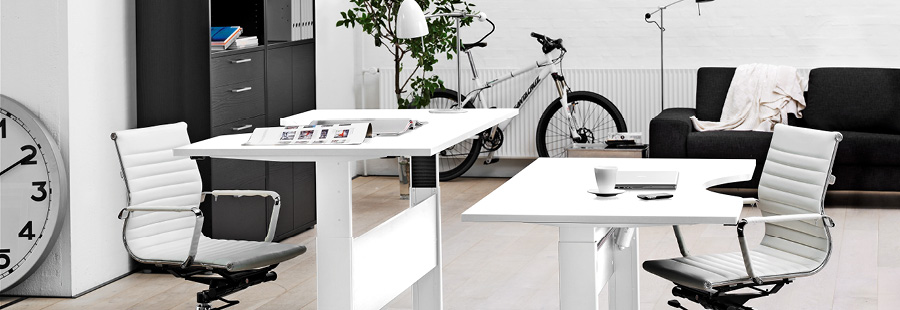
Would you believe the designer of the office cubicle originally intended it to give workers a sense of movement? Today, hoards of Australians are ditching work cubicles in favour of flexible working environments. But it wasn’t long ago that they were the height of innovative office furniture.
Things move on. From rows and rows of cubicles to open workspaces and collaborative areas, the humble office has evolved beyond recognition over the past decade alone.
Did you ever consider how furniture solutions got to where they are now? Take a trip back in time:
Rewind way back to the 1876 Centennial Exposition in Philadelphia, USA, where fancy rolltop desks and filing systems turn heads for the first time. Two decades later, in 1899, Henry van de Velde’s dynamic curving Art Nouveau desk is a sign of things to come.
The rise of secretaries, stenographers, and typists lead to an office design known as “Taylorism”. Obsessed with efficiency and oversight, American engineer Frederick Taylor designs an office that crowds workers together in a large open plan space, with bosses looking on from their private offices – much like a factory floor.
At the same time, the invention of the typewriter and its growing importance in the office means the rolltop desk is on its way out. The typewriter desk soon takes its place, far smaller and lower than today’s desks. It stays right there until the arrival of the PC in the ‘80s.
The ‘50s office is a serious affair where dark wood, pen and paper reigned supreme. Everything is stored on paper and in books, making functional storage and filing systems critical. Furniture solutions, such as desks, chairs and storage, are typically made from dark solid timber to give the impression that this is a serious place for serious business.
In the 1960s, while shrieking Australians and New Zealanders line the streets to get a glimpse of the Beatles, managers emerge from their executive offices to work side-by-side with junior staff in an open plan layout. This is the era of Bürolandschaft, the German-style office planning system in which offices feel more like factories.
Meanwhile, over in Michigan, an inventor called Robert Probst doesn’t like the factory line. He believes it’s all based on hierarchy and status. So, while employed by leading furniture company Herman Miller, he conducts lots of research based on anthropology, psychology and ergonomics and uses the results to develop the radical Action Office 1 – aka the “cubicle”.
Action comes out in 1968 and is a big hit in the office industry. Essentially, it’s a modular business furniture system featuring partitions, display shelves and flexible workspaces designed to increase privacy and productivity. What’s really interesting is that Probst’s cubicle was actually all about movement – that’s why it was called “Action Office”. He was ahead of his time, as he was also a big believer in standing while you work, believing it makes you more alert and productive.
At the same time, research into employee health and wellbeing leads to the arrival of ergonomic chairs. People realise, for the first time, that adjustable chairs could help reduce fatigue and increase productivity.
A new class of worker emerges in the ‘80s: the middle manager. Too senior for a mere desk but too junior for a private office, the middle manager is accommodated in the cheapest way possible – using modular walls. And so the cube farm is born – complete with swivel chairs, of course. Word processors and monitor screens also arrive on the scene, demanding larger desks.
It’s the nineties and dot-com enters the office with a bang, bringing the need for more collaboration, interaction and endless PC accessories. Cubicles get lower and sprawling built-in desks are covered in computer accessories and wires. The comfort factor increases as office chairs become even more user friendly with easy reclining functions and self-adjusting systems.
Y2K might have brought the dot-com crash, but it also signals the start of a digital revolution. Inspired by Google and other tech giants, organisations rethink their furniture solutions to encourage collaboration and communication. Goodbye cubicles. Hello pods. Workstations replace desks, filing systems lose real estate as online storage takes over, and the shrinking size of technology means workspaces got smaller.
Where are we now? Furniture solutions have moved away from cubicles to encourage sociability and collaboration. Partitions are low or non-existent. Timber has given way to colour and vibrancy. The combination of portable technology with online working means workstations are less cluttered than ever.
But perhaps the biggest shift comes from the major emphasis on employee health and wellbeing. You have more ergonomic furniture solutions customised to the individual than ever. Probst has finally got his wish: standing desks, and desks that go from sitting to standing, are helping workers avoid the health issues associated with sitting all day.
Imagine that you can move around and work in all different types of environments. You might start out at your desk, then pack up your laptop to some comfy couches for an impromptu meeting with teammates. After a break in the kitchen hub, where you catch up with people from other departments, you spend a couple of hours standing at a workstation before moving to a quiet space. This is the workplace of tomorrow. At Winc, we truly understand the future of working – a future that’s more connected and creative. And we’ve got the furniture solutions you need to get there, designed for you and yours.